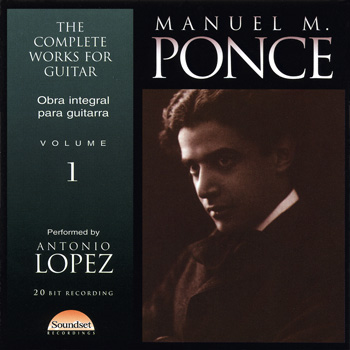Written in 1925, the Sonata Mexicana is Ponce's first full-fledged piece for the guitar. Its sound quality, if not strictly Mexican or Mexican-oriented, is nonetheless unmistakably Latin. The piece features, among other traits, an intelligent use of harmonics throughout its four movements. The first movement is very clear in its thematic material and boasts a compact and precise structural development. The second movement, like so many of Ponce's guitar pieces, is imbued with the sounds of popular song, filtered and refined through the composer’s special sensitivity. Of the four movements, the third one is clearly the closest to the roots of the vernacular; witness the brief quotation of the popular dance, the Jarabe tapatío, that occurs toward the end of the piece. This Intermezzo had been written earlier, in 1923, under the title From Mexico: a page for Andrés Segovia, and was not only the beginning of his production for the guitar, but also the start of the long and fruitful collaboration of 25 years between composer and performer. The final Allegretto of the Sonata Mexicana is very similar to the first movement in its spirit and development, and, in particular its syncopation. Another main feature is Ponce's elegant use of harmonics as integral parts of the melodic material, not simply as ornaments.
The brief Preludio was written in Paris toward the end of 1925. It is characterized by sinuous melodic contours built on alternatively ascending and descending figures in which the interval relationships have been wisely balanced by the composer. In his edition of this piece, Segovia suggests using a capotasto, no doubt to facilitate some problems of fingering; however, for this recording and following the letter and the spirit of Ponce's original manuscript, Antonio López Palacios performs the Preludio without the capotasto. In the extensive correspondence between Ponce and Segovia there are hints that the Mexican composer originally had intended to write a fugue to complement this Preludio; regrettably, this intention remained unfulfilled.
Thème varié et Finale is especially noteworthy for its balance between the variations, an attitude that openly contradicts the usual custom of writing sharply contrasting series of variations. In fact, all the variations in this work are very similar in their spirit and their development. Especially interesting is the fifth variation, in which Ponce adds a few touches that are clearly Spanish in inspiration but subtly harmonized in a manner that elegantly evades any lapse into picturesque folklore. Moreover, instead of concluding the set of six variations with a brilliant and powerful finale, as is the usual custom, Ponce chooses a quiet and moderate ending (although technically quite demanding) much in the spirit of the original theme. Written in 1926 and premiered that same year by Segovia in the French city of Evian, this was the first of many guitar pieces by Ponce published by the house of Schott in Segovia’s editions.
In the Sonata III (1927) Ponce uses a harmonic language that is more modern than that of the Sonata Mexicana and it is cast only in three movements, a structure in which a scherzo or minuet would be missing. The second movement, Chanson, is especially noteworthy. Its title seems to refer to Ponce's French affinities, but in reality it is very similar to the old Catalan song El testamento de Amelia, widely known through the guitar arrangement made by Miguel Llobet (1878-1938). This subtle Chanson also has a middle section that is livelier in its rhythm. In the third movement, Ponce again refers to Spanish music with thematic material anchored in scales and repeated notes that convey a very attractive rhythmic impulse. This Allegro non troppo, in its structure and its spirit, at times seems like a rondo capriccioso. Here, Ponce utilizes an unusual resource, generating repetitions of a particular scale from a tremolo. The ending is atypical of fast movements with its delicate mood and soft touches in harmonics. Because of its language, simultaneously modern and neoclassical, the Sonata III has elements in common with the Sonata for guitar and harpsichord, the Variations and fugue on Las Folías de España, the Preludio and the Thème varié et Finale, works written by Ponce in Paris in the period between 1925 and 1929.
Those who listen to Ponce's Sonata Clásica (1928) for the first time are immediately transported to the nineteenth century, and perhaps even earlier. Written as an homage to the great Catalan guitarist Fernando Sor (1778-1839), the Sonata Clásica is surprising in its inclusion of certain figurations that seem to come from a keyboard instead of a plucked-string instrument. Nevertheless, most of the thematic material is clearly and unmistakably suited for the guitar. The Andante is in a courtly vein, and this is also true of the Menuet. In this movement, clearly built on a three-part (A-B-A) layout, Ponce uses a quite interesting effect of muted strings (pizzicato) to produce a very attractive color. As is the case with his other sonatas, the fourth movement is very similar to the first movement in its conception and its realization.
Ponce's versions of the Cuatro canciones populares recorded here are a good example of the kind of light and discreet nationalism the composer practiced in some of his works. Estrellita, surely the best-known and appreciated (although not necessarily the best) of Ponce's works, is a song which clearly belongs in the more sentimental vein of the popular ballad. Por tí mi corazón belongs to the same spirit, but it is indeed a bit less romantic. The other two songs in the series, La Pajarera and La Valentina come from the world of Mexican country music. Here Ponce has managed to sidestep the strict use of the traditional harmony in parallel thirds (although he seems to flirt with it at certain points); this new treatment of harmony is, in fact, the main asset of Ponce's song transcriptions. La Valentina is probably the composer’s best achievement in this field.
Juan Arturo Brennan
The brief Preludio was written in Paris toward the end of 1925. It is characterized by sinuous melodic contours built on alternatively ascending and descending figures in which the interval relationships have been wisely balanced by the composer. In his edition of this piece, Segovia suggests using a capotasto, no doubt to facilitate some problems of fingering; however, for this recording and following the letter and the spirit of Ponce's original manuscript, Antonio López Palacios performs the Preludio without the capotasto. In the extensive correspondence between Ponce and Segovia there are hints that the Mexican composer originally had intended to write a fugue to complement this Preludio; regrettably, this intention remained unfulfilled.
Thème varié et Finale is especially noteworthy for its balance between the variations, an attitude that openly contradicts the usual custom of writing sharply contrasting series of variations. In fact, all the variations in this work are very similar in their spirit and their development. Especially interesting is the fifth variation, in which Ponce adds a few touches that are clearly Spanish in inspiration but subtly harmonized in a manner that elegantly evades any lapse into picturesque folklore. Moreover, instead of concluding the set of six variations with a brilliant and powerful finale, as is the usual custom, Ponce chooses a quiet and moderate ending (although technically quite demanding) much in the spirit of the original theme. Written in 1926 and premiered that same year by Segovia in the French city of Evian, this was the first of many guitar pieces by Ponce published by the house of Schott in Segovia’s editions.
In the Sonata III (1927) Ponce uses a harmonic language that is more modern than that of the Sonata Mexicana and it is cast only in three movements, a structure in which a scherzo or minuet would be missing. The second movement, Chanson, is especially noteworthy. Its title seems to refer to Ponce's French affinities, but in reality it is very similar to the old Catalan song El testamento de Amelia, widely known through the guitar arrangement made by Miguel Llobet (1878-1938). This subtle Chanson also has a middle section that is livelier in its rhythm. In the third movement, Ponce again refers to Spanish music with thematic material anchored in scales and repeated notes that convey a very attractive rhythmic impulse. This Allegro non troppo, in its structure and its spirit, at times seems like a rondo capriccioso. Here, Ponce utilizes an unusual resource, generating repetitions of a particular scale from a tremolo. The ending is atypical of fast movements with its delicate mood and soft touches in harmonics. Because of its language, simultaneously modern and neoclassical, the Sonata III has elements in common with the Sonata for guitar and harpsichord, the Variations and fugue on Las Folías de España, the Preludio and the Thème varié et Finale, works written by Ponce in Paris in the period between 1925 and 1929.
Those who listen to Ponce's Sonata Clásica (1928) for the first time are immediately transported to the nineteenth century, and perhaps even earlier. Written as an homage to the great Catalan guitarist Fernando Sor (1778-1839), the Sonata Clásica is surprising in its inclusion of certain figurations that seem to come from a keyboard instead of a plucked-string instrument. Nevertheless, most of the thematic material is clearly and unmistakably suited for the guitar. The Andante is in a courtly vein, and this is also true of the Menuet. In this movement, clearly built on a three-part (A-B-A) layout, Ponce uses a quite interesting effect of muted strings (pizzicato) to produce a very attractive color. As is the case with his other sonatas, the fourth movement is very similar to the first movement in its conception and its realization.
Ponce's versions of the Cuatro canciones populares recorded here are a good example of the kind of light and discreet nationalism the composer practiced in some of his works. Estrellita, surely the best-known and appreciated (although not necessarily the best) of Ponce's works, is a song which clearly belongs in the more sentimental vein of the popular ballad. Por tí mi corazón belongs to the same spirit, but it is indeed a bit less romantic. The other two songs in the series, La Pajarera and La Valentina come from the world of Mexican country music. Here Ponce has managed to sidestep the strict use of the traditional harmony in parallel thirds (although he seems to flirt with it at certain points); this new treatment of harmony is, in fact, the main asset of Ponce's song transcriptions. La Valentina is probably the composer’s best achievement in this field.
Juan Arturo Brennan




